Siege warfare played a massive role in history. Some of the most iconic battles in our past have involved sieges. This has crept into the fantasy genre too, and over the years, many an author has included epic siege battles in their stories. Below, we’ll take a look at examples of sieges in writing.
We’ll also examine the ins and outs of siege warfare—how castles were defended and how they were overcome.
If you’d like to learn more about castles and how to use them in your fantasy writing, see my two related guides:
- How To Create A Fantasy Castle
- Fortifications Of A Castle
What Are Siege Tactics?
Siege tactics were a key component of medieval warfare, and understanding them can give us insight into the strategies and methods used by armies during this time period. At their most basic level, siege tactics were techniques used to overcome the defenses of a castle or fortress and gain entry.
One of the most common tactics was the use of siege engines, such as trebuchets, battering rams, and siege towers. These massive structures were used to breach the walls of a castle and allow the attackers to enter. For example, trebuchets were giant catapults that could hurl stones and other heavy objects at the walls of a castle, weakening the defenses and making it easier for the attackers to breach the walls.
Let’s take a look at some specific methods of attack.
Examples Of Siege Warfare In The Fantasy Genre
Some of the most iconic scenes in fantasy involve sieges—Helms Deep, Dros Delnoch, Minas Tirith.
A lot goes into a siege logistically and tactically, meaning it’s crucial to have a good understanding of techniques to get by defensive structures.
Historically, the development of fortifications and the development of siege tactics were linked. It seems to be human nature that if someone builds a wall, someone else wants to tear it down.
The best way to explore siege warfare tactics is to work our way through a siege from the perspective of the attackers.
Moats
The first obstacle any attacker would have to overcome is the moat (if there is one). If the moat was small and shallow it could either be jumped across or planks placed over it to make walkways. Any bigger and it had to be filled in.
If it was a water-filled moat, that water first had to be drained out, and one way of doing so was by digging drainage holes and then connecting them to the moat. Rocks, dirt, wood, or whatever else the attackers could get a hold of, were used to fill in the moat. Not only did the attackers have to do all this manual labour, but they had a load of archers raining hellfire at them.
As we’ve seen in other guides on the lives of medieval peasants, moats were often filled with excrement of the human variety. This encircling body of water provided a convenient means of empty chamber pots. Or in some medieval castles, the privy consisted of a hole in the stone that looked out over the moat.
So if you were an attacker, it’s also likely that the process of dealing with a moat would have been mightily smelly.
Further Reading – Using The 5 Senses In Writing

Good luck filling that moat in
The Battering Ram
Moat dealt with, next came the gate and walls. One of the oldest siege warfare tactics but most efficient methods of getting through a gate was a battering ram, which consisted of a heavy log or tree trunk. A battering ram carried by men alone was sufficient to get through small gates, but larger gates required something a bit more robust.

Enter the cat, a carriage in which a battering ram was hung and then swung at the gate. It was also known as the mouse, weasel, and sow. To increase the strength of the ram it was banded with iron rings and reinforced with an iron head to stop it from shattering.
The carriage had a roof covered with wet hides to protect the ram operators from projectiles and fire. Instead of a ram, some cats had an iron pole attachment which was used to chisel away at the mortar of the walls. Cats were also used without a ram to provide a safe space for siege engineers to go about undermining the walls or filling in moats.
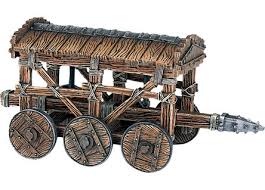
To counter these cats, the defenders used a few cunning tactics. The easiest one was to smash them to bits with heavy rocks. Another tactic adopted by the Muslims in the Levant and adopted later by the Crusaders was to try and hook the ram and flip it over. Apparently, it was pretty effective.
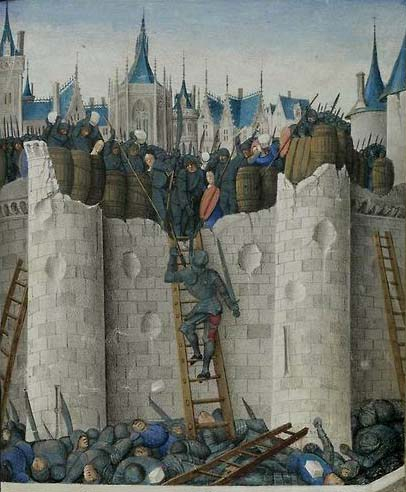
The Good Old Ladder
The quickest, most direct and straightforward approach to overcoming the walls and gate was the escalade: scaling the walls with the help of a ladder.
It was a tad dangerous, though, suicidal in some cases, with no protection other than the armour on their backs and the cover of friendly archers.
When the height of walls was raised later in the Middle Ages this approach became redundant.
Siege Towers
And so the siege tower came about, also known as the belfry. This siege engine has ancient roots beyond the Middle Ages but was a tactic of siege warfare featured heavily during The Age of Castles. It consisted of a wooden tower built on wheels. Inside were several levels which the attackers could ascend.
The top-level usually consisted of a drawbridge that could be lowered onto the battlements and from there the attackers poured forth. Some had a level above this which provided a platform for attacking archers to shoot at those upon the battlements. And some towers even had a battering ram on the bottom level. The above image shows all three.
Mantlet
The siege tower did have weaknesses. Being wooden it was susceptible to fire, which is why they were usually covered in wet hides. One type of fluid used to wet the hides was urine. So before battle piss was splashed about, leaving a nice stench to emanate across the battlefield. Lovely. The transportation of siege towers was also tricky. Given their shape they were prone to toppling when on uneven ground, which was tricky when faced with moats or inclines.
It was imperative to the success of a siege to pin down the defenders with archery and missile fire which allowed the siege equipment to advance. Attackers set up contraptions called mantlets, which were wooden shields held upright by beams, around 2m by 2m, to allow archers to provide cover.
Mining
One of the main tactics of siege warfare adopted to bring down a wall, and perhaps the most dangerous, was mining. Under the protection of cats and hefty shields, miners used picks and other tools to destabilise walls.
Moats made mining difficult. One of sufficient depth could dissuade even the most ambitious of miners, but shallower moats could be dug under. Reaching the foundations of the wall, the miners filled the tunnel with flammable objects and set it afire. The tunnel supports collapsed in the heat, bringing down the tunnel and the ground above. So too went the base of the wall.
The defenders had methods for detecting when a mine was being dug. They used the Jurassic Park method of watching a bowl of water for ripples. To defend against mines they dug counter-mines to collapse those of the attackers, smoked them out, or sent down troops to kill the diggers, ending the threat by collapsing the mine.
Projectiles
There were a number of projectile-hurling siege weapons used in the Middle Ages, each with its strengths and limitations.
Crafted in the Roman era, the ballista was a giant crossbow. A single bolt could cleave through groups of men, though it wasn’t much use against stone walls.
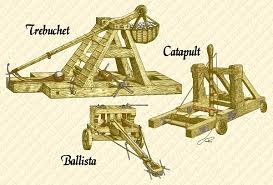
There was the catapult too, also known as the mangonel, which consisted of a wooden beam with a bowl at one end. The beam was winched down and released to spring the contents of the bowl forwards. Projectiles from catapults had a low velocity and usually weren’t heavy enough to cause significant damage. It had a range of about 500 meters, beyond the reach of archers. Catapults were used in groups, or batteries, to target sections of wall or defensive positions. Using them in such clusters caused massive damage.
The trebuchet was similar to the catapult but instead of a bowl, it had a sling in which projectiles could be loaded and hurled. It was better able to throw heavier missiles than the catapult—as heavy as 150 kilograms, which is about the weight of a panda. Yes, a panda. It operated much like the modern-day mortar, low velocity but a high trajectory, and it was much more accurate and destructive than the ballista or catapult. It had a range similar to the catapult, if not a little greater.
One of the latterly adopted weapons in siege warfare used in the Middles Ages was the cannon. In the 14th century, the technology was in its infancy so they were small and ineffective against walls. It was only in the 16th century did they become a force to be reckoned with.
I found cannons so interesting that I used them in my debut novel, Pariah’s Lament.
Waiting It Out
Another option that besiegers could take was to seal off the keep and prevent any supplies from getting inside. This, in turn, leads to hunger, thirst and disease, which can either force an enemy to submit and open its gates, succumb to death, or weaken the defenders so much that an attack blows them away.
Depending on how well-stocked the keep is with supplies, it could take months or even years for the defenders to lose supplies. Here are some examples:
- The Siege of Candia (Crete 1648-1669) lasted an incredible 21 years. People born in the early years of the siege ended up fighting in the final battles.
- The Siege of Thessalonica is another example of something that turned into a bit of an epic. It lasted for eight years between 1422 and 1430 before the defenders finally succumbed and the city was pillaged and destroyed.
- The Rome/Carthage clashes (known as the Punic Wars) were some of the bloodiest in history. Between 249 and 241 BC, the Romans pursued the Siege of Drepana. Drepana was a Carthaginian naval stronghold the Romans struggled to overcome until at last they raised a large enough force to overcome it.
“War of attrition” is a phrase you may have heard and it very much applies to siege warfare.
Summarising Siege Warfare
We’ve taken a good look at the various steps that besiegers can take to overcome the fortifications that stand in their path. Many of the siege tactics we’ve covered involved brute force—overcoming the defenders with weapons, numbers and sheer cunning.
As I mentioned at the beginning, siege warfare followed something of a cause and effect approach. Defensive structures were created and weapons and tactics were created to overcome them.
Therefore, when it comes to writing about sieges, the starting point is to look at the defensive features of the castle, fortress or keep. The gatehouse is naturally the weakest part of any keep, so it makes sense for more fortifications to be placed there.
How then do your attackers overcome that? Do they develop weapons, like siege towers or cannons (like in Pariah’s Lament), or does one of the attackers have inside knowledge of weaknesses or potential breaches? Perhaps sheer force of numbers is the tactic they hope to use to overcome them.
And of course, you can always wait it out—starve the inhabitants of supplies until at last they succumb to either disease, thirst and hunger.
Sieges are conflict-ridden scenes and can be immensely entertaining to read. But they require research of siege warfare tactics, and I hope this guide has provided you with that.
Further Reading – How To Write Battle Scenes
Other Types Of Siege Tactics
As we’ve seen, various siege tactics were developed to try and overcome the formidable defenses of castles. Some were more destructive and blunt than others.
But there were other types of tactics that besiegers adopted which proved effective in some cases.
One approach was to unleash a campaign of psychological warfare. Attackers would often try to demoralize the defenders by using loud noises, such as drums and horns to disrupt their sleep, or by erecting frightening effigies or figures on the battlefield.
Attackers would sometimes send messengers or letters to the defenders, informing them of the impending attack and warning them of the dire consequences of resisting. These messages could be accompanied by gruesome images or threats of violence to frighten the defenders.
It wasn’t uncommon for attackers to try to contaminate the water supply or throw diseased animals over the walls of the castle in an attempt to spread disease and weaken the defenders. They might also use foul smells and waste to make the defenders feel uncomfortable and sick.
All of these tactics were designed to create a sense of fear and uncertainty among the defenders and to make them question their ability to withstand the attack.
Used in combination with more traditional siege tactics, such as battering rams and siege towers, they could be particularly effective and make them more vulnerable to attack.
What About The Defenders In Siege Warfare?
What did the defenders have at their disposal? Well, they possessed the same siege weapons as the attackers: ballista, catapults, trebuchets, and cannons. Ballistae were usually placed atop towers and were used to target belfries and cats, as well as large groups of attackers. Catapults and trebuchets were normally found in courtyards and again used to destroy belfries and such.
Learn More About Siege Warfare And Medieval Life
Before we complete this guide on siege warfare, I wanted to point you in the direction of some other guides that you may find useful.
- A complete guide to worldbuilding, with a template – here you can find a free template to help you create your fantasy worlds
- A guide to medieval weapons – there were a wide range of weapons in the Middle Ages and here you can learn all about them.
- Medieval armor and the fantasy genre – from chain mail to plate armor, learn it all here
- The lives of medieval lords – the gentry lived an interesting life in the medieval period. Learn all about it here
- How were women treated in the Middle Ages? – women were treated poorly in medieval times. Discover how and why
- The lives of peasants in the medieval period – peasants lived rich and colourful lives. This guide explores it in detail
- A guide to medieval castles – learn all about these impressive fortifcations
- A complete guide to medieval cannons – one of the most effective methods of defeating a castle’s fortifications were cannons
- Roman battle tactics – the Romans had one of the finest militaries in history. This guide explores their tactics
- How to build a fantasy world – this complete guide covers worldbuildings
- Worldbuilding in fantasy – learn the ins and outs of creating worlds from scratch
- 5 Tips to Help Your Child Learn and Succeed at Primary School - February 26, 2024
- The Advantages Of Using An AI Essay Typer Alternative - February 14, 2024
- Advice On Getting Help With Your Homework - January 26, 2024

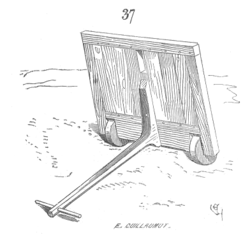
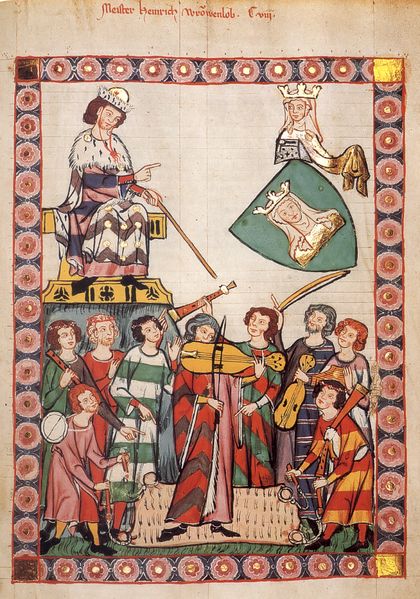
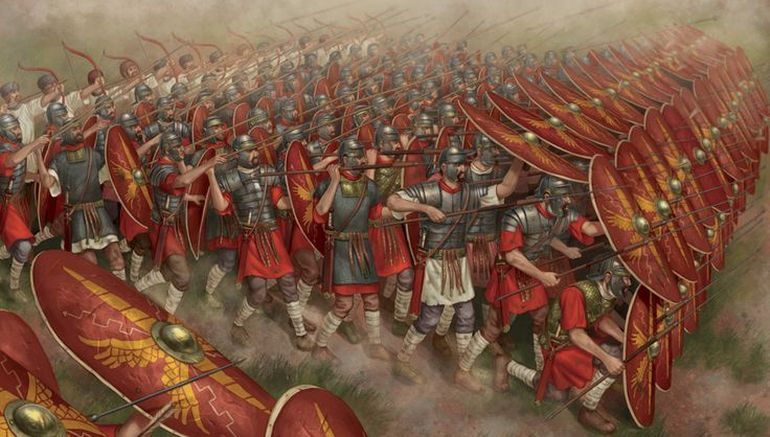

Another fantastic and informative article from you Richie!
Too kind, Kayla! I’m delighted you found it useful. Thanks for reading!
Very cool info here. I’m sure I will be using it in some future story of mine. 😀
Pingback: A Fantasy Writer’s Guide to … Castles and Keeps: Part I – Richie Billing
Pingback: World-building: Battle Tactics I – Richie Billing
Pingback: A Fantasy Writer’s Guide to … Castles and Keeps: Part II – Richie Billing
Pingback: How To Create A Fantasy Castle - The Ultimate Guide | Richie Billing
Pingback: The Lives Of Medieval Peasants - Richie Billing